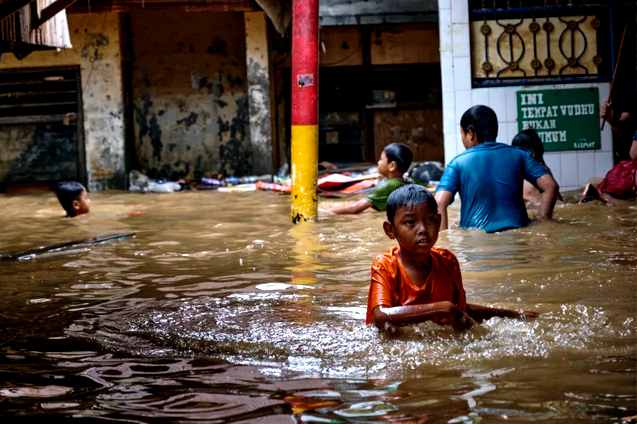Indonesia has been identified as the country with the most land at risk of sea level rise, adding to the threats climate change will pose to Australia’s populous northern neighbour.
New satellite data has found Indonesia has 118,200 square kilometres of land at two metres or less above mean sea level, or an area 14 times larger than previously thought, according to research published Wednesday in the Nature Communications journal.
That land, which amounts to about 6.3 per cent of the archipelago, is already home to 17.2 million people.
Assuming seas will rise about a metre by 2100 as the climate heats up, those at risk will swell to 410 million even assuming no population increase, with about 72 per cent of them living in the tropics, it said.
“Consequently, whether measured by area, population size or population growth, the burdens of relative sea-level rise are likely to fall [disproportionately] upon developing countries in the tropics that often have limited capacity to adapt,” the paper said.
Vanishing coast  |
| Thousands of kilometres of Australia's beaches at risk from
rising seas |
The work, done to 5-kilometre resolutions, would be refined further to 1-kilometre, he told the Herald and The Age.
Dr Hooijer said land elevation data had received relatively limited scientific interest so far, simply because existing data was highly inaccurate with errors well over one metre.
“Our new data show coastal lands to be substantially lower than was known before, which will translate into substantially higher flood risk of course,” he said.
 |
| Indonesia faces multiple climate change risks, with sea-level rises
just one of them, according to Robert Glasser at the Australian
Strategic Policy Institute. Credit: Getty Images |
Climate policy  |
| Failure to model costs of climate change to coal, gas ‘beggars
belief’ |
“If people are being flooded and flooded over and over again, people tend to move,” Dr Glasser said. “The pressures on places like Indonesia are going to be enormous.”
In his report, Dr Glasser said the wider Southeast Asian region faced “a dangerous constellation of simultaneous climate hazards” that would pose national security issues for Australia quite apart from its own exposure to threats from a warming world.
“Sea-level there is rising four times faster than the global average, driven by climate change and other factors, such as groundwater extraction,” he wrote.
Even so, most analyses treated climate risks as independent, rather than considering how they would likely interact, his report noted.
A study of the impact that rising temperatures will have on agricultural productivity, for instance, would typically overlook the compounding impacts of other hazards such as flooding, drought, fires, increases of pests, saltwater inundation, cyclones, migrations of people, and so on.
“The hazards are many and the cascades will affect everything,” Dr Glasser said.
Links
- Nature Communications: Global LiDAR land elevation data reveal greatest sea-level rise vulnerability in the tropics
- Australian Strategic Policy Institute: The rapidly emerging crisis on our doorstep
- (UK The Conversation) Five Satellite Images That Show How Fast Our Planet Is Changing
- (The Guardian) Global Heating Pace Risks ‘Unstoppable’ Sea Level Rise As Antarctic Ice Sheet Melts
- (The Guardian USA) Sea Levels Are Going To Rise By At Least 20ft. We Can Do Something About It
- Sinking Land And Rising Seas: The Dual Crises Facing Coastal Communities
- (NZ) When Climate Change And Other Emergencies Threaten Where We Live, How Will We Manage Our Retreat?
- Sea Level Data Confirms Climate Modeling Projections Were Right


No comments :
Post a Comment